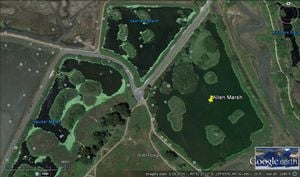
Enhancement Ponds[edit | edit source]
Arcata marsh enhancement ponds[edit | edit source]
The enhancement ponds consists of three ponds: the George Allen, Robert Gearheart and Dan Hauser ponds. The total area covers 30 acres.[2]
History[edit | edit source]
In 1972, the Clean Water Act [3] prohibited discharge wastewater into any enclosed bay or estuary unless it could demonstrate "enhancement of the receiving waters."[4] The existing waste water plant at the time was only treating their water with primary treatment before releasing it into the bay. The most economical thing for the City of Arcata to do was expand the existing facilites to treat the waste water even further before releasing it into the bay.[5]
In 1977, the idea of enhancement ponds were developed and Dr. George Allen, Dr. Bob Gearheart, Public Works Director, Frank Klopp and City Councilman, Dan Hauser, pushed the idea through the city and county councils. [6] The city was given permission to install the ponds to enhance the discharge water. By 1986, the marshes were completed.
Enhancement Ponds[edit | edit source]
The enhancement ponds are part of the tertiary treatment system of the waste water plant. Secondary treatment process and disinfection can remove 85% of the BOD and suspended solids and nearly all the pathogens, but there are pollutants (nitrogen, phospohrous, soluable COD and heavey metals) still lingering.[1]
This water is treated in the enhancement ponds where biological processes remove the remaining pollutants before the water is released into the bay. Phosphorous can be removed by a chemical percipitation using one of three compounds: ferric chloride, aluminum or lime.[1] Nitrogen needs to be removed from the water in order to control the algae blooms. This can be done biologically or chemically. The nitrification-denitrificationprocess is used at the enhancement marshes.

The water which has been treated by the chlorine has levels of BOD and Total Suspended Solids (SS) less than 10 mg/L and Total Inorganic Nitrogen (TIN) is less than 5mg/L.[7]
Water starts in the George-Allen marsh, then travels to the Robert Gearheart Marsh and finally to the Dan Hauser marsh; this process can take up to 9 days. [8] Effluent from the Dan Hauser marsh is treated by chlorine a second time and is pumped into the bay. [9]
Plants[edit | edit source]
Plants are essential for the Enhancement Marsh to be successful. Plants help clean the water by providing habitat for fish and birds that eat algae and by providing cover to help control the growth of algae. Willows are known for their ability to absorb toxins out of the soil and cat tails and other grasses are good for habitat and shade. Plants play a role in nitrification-denitrification. The whole ecosystem of a marine environment in Figure 1 is necessary for the process to succeed.
Biodiversity is an important factor in creating a realistic environment. Using native plants in the landscape is key for restoration and rehabilitation. Friends of Arcata Marsh (FOAM) has complied a list of common plants of the Arcata Marsh. These plants include:
| Trees and Shrubs | Wetland Plants | Other Plants |
|---|---|---|
| Big-leaf Maple, Blue Blossom, California Blackberry, Canyon Gooseberry, Cascara Sagrada, Coast Redwood, Coast Willow, Coyote Brush, Himalayan Blackberry, Monterey Pine, Port Orford Cedar, Red Alder, Red Elderberry, Red Flowering Currant, Sitka Spruce, Thimbleberry, Wax Myrtle | Brass Button, Bulrush, Broadleaf Cattail, Common Mare’s-tail, Common Rush, Cordgrass, Duckweed, Jaumea, Marsh Pennywort, Marsh Rosemary, Pickleweed, Saltbrush, Sea-Arrow-grass, Umbrella sedge, Water Parsley, Water Plantain | Birdfoot trefoil, Bracken Fern, Bull Thistle, California Aster, California Poppy, Cat’s Ear, Cinquefoil, Common Horsetail, Common Plantain, Cow Parsnip, Creeping Buttercup, Curly Dock, Douglas Iris, Evening Primrose, Fennel, Fiel Mustard, Foxglove, Gumplant, Lupine, Oxeye Daisey, Pampas Grass, Pearly Everlasting, Poison Hemlock, Rattlesnake Grass, Red Clover, Roadside Everlast Pea, Queen Anne’s Lace, Sheep Sorrel, Sword Fern, Teasel, Yarrow, Yellow Parentucellia |
Pipes[edit | edit source]

Two pipes carry water to and from the enhancement marshes. The pipe attached to the bottom side of the footbridge (Figure 12.) carries water to the enhancement marshes. The lower one, seen south of the bridge, carries water from the enhancement marshes to the chlorination facility. In Figure 12, the return pipe can be seen as a lighter line to the bottom left of the bridge. During a low tide the pipes can be seen under the bridge.
- ---
Update 2014[edit | edit source]

The Enhancement Marshes of the Arcata Wastewater Treatment Plant are all currently in working order. They also continue to hold aesthetic and recreational value to the community.
On two visits to the site I encountered several walkers, joggers and bird watchers. Additionally, there appears to be abundant wildlife and biodiversity within these marshes.
In an interview at City Hall, Julie Neander said that the City of Arcata is still conducting research on whether UV radiation, rather than Sulfur dioxide, as an appropriate method of dechlorination for water coming out of the Chlorine Contact Basin into the Enhancement Marshes and Arcata Bay. Currently, effluent from the the chlorine contact basin is divided into two streams, one portion being discharged directly into Humboldt Bay and the other being discharged into the system of enhancement marshes (EPA 1993) (see flow diagram for more info).

-
Wildlife at the Allen Marsh
-
Wildlife at the Gearheart Marsh
-
Wildlife at the Hauser Marsh
-
Allen Marsh Pipe water flow
-
Wide shot of Allen Marsh pipe
-
Wide shot of Gearheart Pipe
-
Pipe at Gearheart trasnferring water from Allen Marsh To Gearheart






